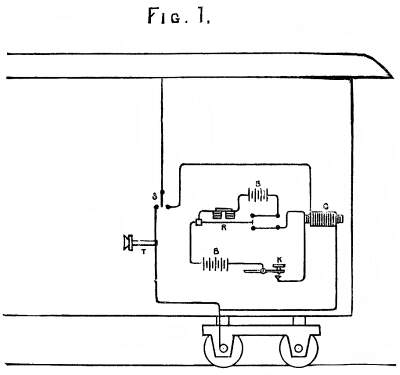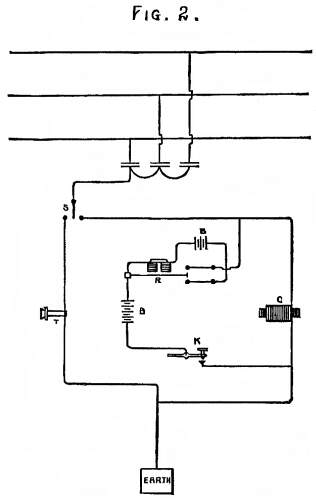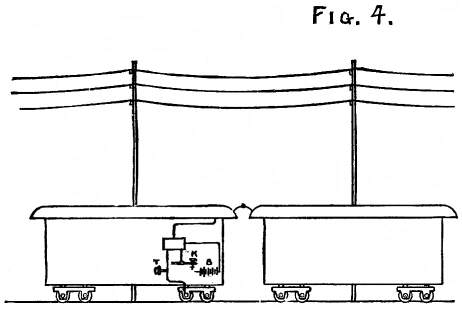THE EDISON SYSTEM OF RAILWAY
TELEGRAPHY.
Scientific American—February 20,
1886
 The announcement
made last summer that Mr. Thomas A. Edison was working out the
details of a system of inductive telegraphy for sending and receiving
messages on moving trains prepared the public for taking a very
lively interest in the week's practical trial of the system, recently
made on the Staten Island Railway. The necessary apparatus was
applied to a car on one of the regular afternoon trains running
from Clifton to Tottenville. The experiments were made personally
interesting by having each member of the party leave a written
message, sealed and directed to himself, with the operator at
Clifton. During the trip, these messages were received on board
the moving train, and each writer had the satisfaction of having
his words correctly returned to him. The announcement
made last summer that Mr. Thomas A. Edison was working out the
details of a system of inductive telegraphy for sending and receiving
messages on moving trains prepared the public for taking a very
lively interest in the week's practical trial of the system, recently
made on the Staten Island Railway. The necessary apparatus was
applied to a car on one of the regular afternoon trains running
from Clifton to Tottenville. The experiments were made personally
interesting by having each member of the party leave a written
message, sealed and directed to himself, with the operator at
Clifton. During the trip, these messages were received on board
the moving train, and each writer had the satisfaction of having
his words correctly returned to him.
The main feature of the system, that of using the ordinary
telegraph wires strung on the poles along the track, in place
of a specially laid wire, as in the Phelps system, was invented
and patented by Mr. William Wiley Smith in the fall of 1881, and
he and Mr. E. T. Gilliland have been associated with Mr. Edison
in the development of this idea.
 The apparatus
on board the train is all attached to a compact operator's desk,
occupying no more room than an ordinary car seat. This desk may
be placed in any part of the car desired, arid may be moved from
one car to another in a few minutes' time. The apparatus consists
of an ordinary Morse key, phonetic receivers, an electro-magnet,
a vibrating reed, an induction coil, and a battery. Similar apparatus
is in use at the fixed stations. With the assistance of our diagrammatic
illustrations, the reader will be able to understand the disposition
of the instruments, and follow the current on its journey from
the key on the train to the receiver at the fixed station, or
vice versa. The car roofs are covered with tin and connected electrically
by copper wire. During the experimental run at Staten Island,
four cars were used. As the induction takes place between the
telegraph wires and the tin roof, it is desirable to have as large
a metallic surface as possible. Under favorable conditions, one
roof will suffice, but it is better to have several. An insulated
wire runs from the roof of the telegraphing car to a switch, S, at the operator's desk. This is shown
open in Fig. 1. When a message is to be received on the
car, the switch is turned to connect with a wire running to the
phonetic receiver, T, and thence
to the, ground. The receiver may be either an ordinary telephone,
or a pair may be used and held to the ears, somewhat after the
manner of ear muffs. After coming from receiver, the wire is carried
under the car and connected with a strip of copper, which is pressed
against a copper cylinder on one of the axles by means of a spring,
thus giving a ground connection by the, axle and wheel. The apparatus
on board the train is all attached to a compact operator's desk,
occupying no more room than an ordinary car seat. This desk may
be placed in any part of the car desired, arid may be moved from
one car to another in a few minutes' time. The apparatus consists
of an ordinary Morse key, phonetic receivers, an electro-magnet,
a vibrating reed, an induction coil, and a battery. Similar apparatus
is in use at the fixed stations. With the assistance of our diagrammatic
illustrations, the reader will be able to understand the disposition
of the instruments, and follow the current on its journey from
the key on the train to the receiver at the fixed station, or
vice versa. The car roofs are covered with tin and connected electrically
by copper wire. During the experimental run at Staten Island,
four cars were used. As the induction takes place between the
telegraph wires and the tin roof, it is desirable to have as large
a metallic surface as possible. Under favorable conditions, one
roof will suffice, but it is better to have several. An insulated
wire runs from the roof of the telegraphing car to a switch, S, at the operator's desk. This is shown
open in Fig. 1. When a message is to be received on the
car, the switch is turned to connect with a wire running to the
phonetic receiver, T, and thence
to the, ground. The receiver may be either an ordinary telephone,
or a pair may be used and held to the ears, somewhat after the
manner of ear muffs. After coming from receiver, the wire is carried
under the car and connected with a strip of copper, which is pressed
against a copper cylinder on one of the axles by means of a spring,
thus giving a ground connection by the, axle and wheel.
When, however, a message is to be transmitted from the car,
the switch is connected with a wire leading to one end of a secondary
coil at C, the other end of which
is connected with the ground wire just described. Inside of this
secondary coil, and  separated
from it by a layer of paper, is the primary coil, which is within
the short electrical circuit represented by the diagram. A ten
cell Fuller battery is placed underneath the desk. One pole of
the battery is connected with the Morse key, K,
which in turn is connected with one end of the primary coil as
shown. The other pole of the battery is connected with a metallic
reed, R, which is made to vibrate
500 times a second by means of a small independent battery. These
vibrations produce a sharp, clear musical note, which is very
audible at short distances from the operator's desk. The free
end of the reed at each vibration strikes against a metallic button,
connected by a wire with the other end of the primary coil. This
being the arrangement of the apparatus on the train, we will suppose
that the message is actually being transmitted. The Morse alphabet
of dash and dot is employed, and consequently any operator can
work the system. When the key is pressed down to form a letter,
the short circuit is closed and the current passes through the
primary coil. But the vibrating read breaks the current each second
into five hundred waves, and these electrical waves induce corresponding
ones in the secondary coil. The function of this induction coil
is to transform the intermittent current into one of high electrical
tension. From the coil the waves pass to the roof, and by a sharp,
quick discharge traverse the intervening air and reach the telegraph
wires. It will be noticed that the word "discharge"
is employed in spite of the fact that the action between the roof
and wires is nevertheless, in strict electrical parlance, one
of induction. This constitutes the point of the invention. separated
from it by a layer of paper, is the primary coil, which is within
the short electrical circuit represented by the diagram. A ten
cell Fuller battery is placed underneath the desk. One pole of
the battery is connected with the Morse key, K,
which in turn is connected with one end of the primary coil as
shown. The other pole of the battery is connected with a metallic
reed, R, which is made to vibrate
500 times a second by means of a small independent battery. These
vibrations produce a sharp, clear musical note, which is very
audible at short distances from the operator's desk. The free
end of the reed at each vibration strikes against a metallic button,
connected by a wire with the other end of the primary coil. This
being the arrangement of the apparatus on the train, we will suppose
that the message is actually being transmitted. The Morse alphabet
of dash and dot is employed, and consequently any operator can
work the system. When the key is pressed down to form a letter,
the short circuit is closed and the current passes through the
primary coil. But the vibrating read breaks the current each second
into five hundred waves, and these electrical waves induce corresponding
ones in the secondary coil. The function of this induction coil
is to transform the intermittent current into one of high electrical
tension. From the coil the waves pass to the roof, and by a sharp,
quick discharge traverse the intervening air and reach the telegraph
wires. It will be noticed that the word "discharge"
is employed in spite of the fact that the action between the roof
and wires is nevertheless, in strict electrical parlance, one
of induction. This constitutes the point of the invention.
Mr. Edison believes that he has made a new discovery in physics.
He finds that bodies hitherto considered nonconductors, such as
air, are really so only after an appreciable period of time. At
the first instant of discharge, the air offers no resistance to
the passage of a current, but becomes almost immediately polarized,
and the communication becomes permanently interrupted. The idea,
therefore, in these very short waves of high tension is to permit
them to cross to the wires before the air has time to offer any
opposition. A sufficient period, however intervenes between them
to permit the air to return to its normal condition, and consequently
allow the succeeding waves to pass. Mr. Edison illustrated this
point to the writer by drawing a series of dots about an inch
apart. The dots represent the waves and the spaces the intervening
air. The polarization of the air attendant upon the passage of
the waves is neutralized before the arrival of the wave following.
The series of waves, having been communicated to the telegraph
wires, are transmitted to every station on the line and to every
train having suitable apparatus. If  the key were held down continuously, simply a musical
note, corresponding to that produced by the vibrating reed, would
be heard in all the receivers. It is the breaking up of this note
into dots and dashes, by means of the key, that transmits the
telegram. the key were held down continuously, simply a musical
note, corresponding to that produced by the vibrating reed, would
be heard in all the receivers. It is the breaking up of this note
into dots and dashes, by means of the key, that transmits the
telegram.
Though the apparatus at the fixed stations is similar to that
on board the trains, the manner of throwing the waves on or off
the telegraph wires is naturally different. Two arrangements are
possible. In the one shown in Fig. 2, condensers are used.
These are simply a series of circular metallic plates, equal in
number to the number of telegraph wires used. One plate is connected
with each wire, and is brought opposite, but not touching, a similar
plate connected with the switch, S,
in the station. The electrical waves pass to the condensers, spring
across the intervening space to those opposite, and so pass on
to the receivers.
In the second arrangement, shown in Fig. 3, no condensers
are used, but the telegraph wires themselves are formed into a
primary coil, and the wires from the office switch form the secondary
coil. This is shown at C. In
this case no further induction coil is needed in the office. The
number of wires necessary for the transmission of the waves will
depend upon circumstances. In case the sound becomes too faint
for convenient translation into words, a greater number of wires
should be employed. At Staten Island four were used and gave very
satisfactory results. The distance from the car roof to the wires
was from 15 to 20 feet. In experiments made at Menlo Park, Mr.
Edison succeeded in transmitting a message through the air over
a distance of 580 feet. It will be observed that the circuit connecting
the operator's key and the receiver is three times broken by the
air, once at the induction coil, once at the roof, and again at
the fixed station, either at the condensers or at the line coil.
 As one of the
chief merits of this system is its inexpensiveness, it may be
of interest to state just what the cost is. The apparatus on board
the train and that at the fixed stations cost about $50 each.
The annual royalty for the use of the system varies from $7 per
mile on roads of five to. six thousand miles to $15 per mile on
roads of a hundred miles or less. The president of the company,
Dr. Crowell, informs us that it is about to be introduced on the
line of the Chicago, Milwaukee, and St. Paul Railway. Of its usefulness
in averting accidents, by keeping each train informed of the whereabouts
of the one immediately ahead or following it, in intercepting
criminals, and in promoting general social and commercial intercourse,
it will be unnecessary to speak. As one of the
chief merits of this system is its inexpensiveness, it may be
of interest to state just what the cost is. The apparatus on board
the train and that at the fixed stations cost about $50 each.
The annual royalty for the use of the system varies from $7 per
mile on roads of five to. six thousand miles to $15 per mile on
roads of a hundred miles or less. The president of the company,
Dr. Crowell, informs us that it is about to be introduced on the
line of the Chicago, Milwaukee, and St. Paul Railway. Of its usefulness
in averting accidents, by keeping each train informed of the whereabouts
of the one immediately ahead or following it, in intercepting
criminals, and in promoting general social and commercial intercourse,
it will be unnecessary to speak.
We are indebted to Frank Leslie's Illustrated Newspaper
for the use of the large cut.
Stories Page | Contents Page
|







